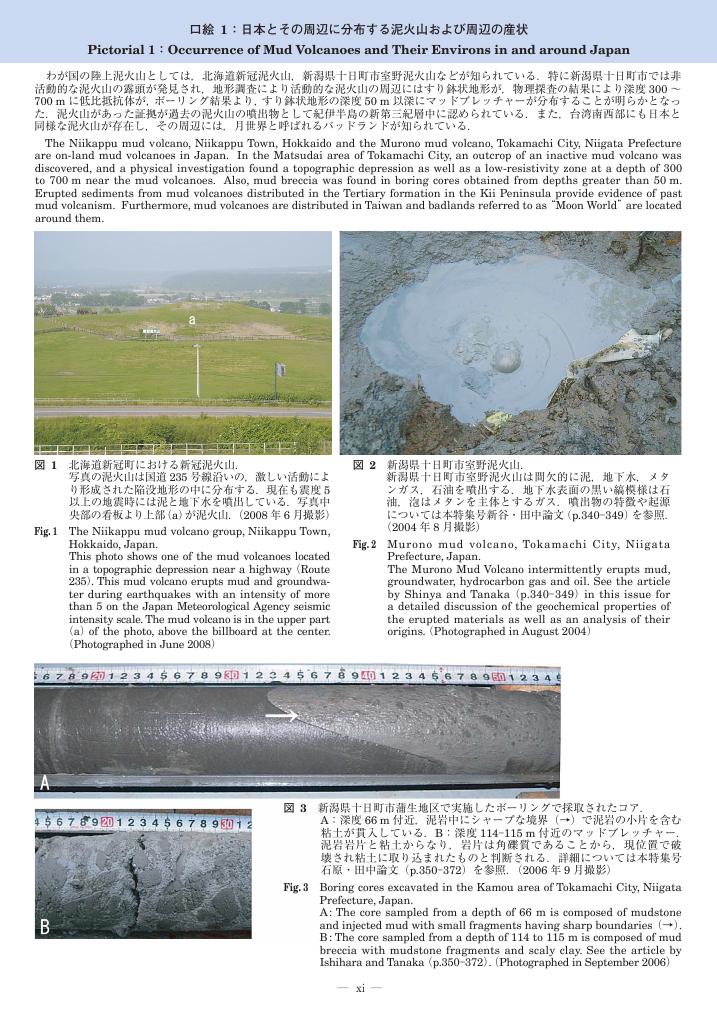66 0 0 0 OA 鍋立山トンネル周辺の泥火山の活動と膨張性地山の成因
- 著者
- 田中 和広 石原 朋和
- 出版者
- 公益社団法人 東京地学協会
- 雑誌
- 地学雑誌 (ISSN:0022135X)
- 巻号頁・発行日
- vol.118, no.3, pp.499-510, 2009-06-25 (Released:2010-03-26)
- 参考文献数
- 34
- 被引用文献数
- 6 10
The Nabetachiyama Tunnel 9116 m long was excavated in Tokamachi City, Niigata Prefecture and encountered the serious difficulties during excavation. In particular, a 600 m long section in the Matsudai area had experienced difficulties caused by swelling mudstone in the Tertiary Sugawa Formation. A 120 m bore hole long was excavated in the neighborhood of the section and geological and geochemical examinations of sampled cores were carried out to investigate the formation mechanism of the swelling rock mass. Mudstone distributed deeper than 50 m in the bore hole can be correlated to the tunnel troubled section geologically and geochemically. The section is assumed to be composed of mud breccia with mudstone fragments and clayey matrix, which is thought to be generated by hydro-fracturing of mudstone, showing weak strength due to large quantities of clay minerals. A gas pressure of 1.6 MPa thought to be caused by degassing of methane was measured during tunnel construction, which would increase the swelling properties. Mud breccia distributed deeper than 50 m contains a lot of Na-smectite formed in highly saline pore water ascending from deep underground. The result of slaking test showed that mud breccia filled with saline groundwater is characterized by quick slaking and swelling due to the marked contraction of Na-smectite when drying. In summary, the swelling rock mass distributed in the troubled section was formed by the weak rock strength caused by hydro-fracturing and high gaseous pressure generated by degassing. Furthermore, quick slaking caused by repeated wetting and drying was another reason for swelling during excavation.
3 0 0 0 鍋立山トンネル周辺の泥火山の活動と膨張性地山の成因
- 著者
- 田中 和広 石原 朋和
- 出版者
- Tokyo Geographical Society
- 雑誌
- 地學雜誌 (ISSN:0022135X)
- 巻号頁・発行日
- vol.118, no.3, pp.499-510, 2009-07-07
- 被引用文献数
- 5 10
The Nabetachiyama Tunnel 9116 m long was excavated in Tokamachi City, Niigata Prefecture and encountered the serious difficulties during excavation. In particular, a 600 m long section in the Matsudai area had experienced difficulties caused by swelling mudstone in the Tertiary Sugawa Formation. A 120 m bore hole long was excavated in the neighborhood of the section and geological and geochemical examinations of sampled cores were carried out to investigate the formation mechanism of the swelling rock mass. Mudstone distributed deeper than 50 m in the bore hole can be correlated to the tunnel troubled section geologically and geochemically. The section is assumed to be composed of mud breccia with mudstone fragments and clayey matrix, which is thought to be generated by hydro-fracturing of mudstone, showing weak strength due to large quantities of clay minerals. A gas pressure of 1.6 MPa thought to be caused by degassing of methane was measured during tunnel construction, which would increase the swelling properties. Mud breccia distributed deeper than 50 m contains a lot of Na-smectite formed in highly saline pore water ascending from deep underground. The result of slaking test showed that mud breccia filled with saline groundwater is characterized by quick slaking and swelling due to the marked contraction of Na-smectite when drying. In summary, the swelling rock mass distributed in the troubled section was formed by the weak rock strength caused by hydro-fracturing and high gaseous pressure generated by degassing. Furthermore, quick slaking caused by repeated wetting and drying was another reason for swelling during excavation.
